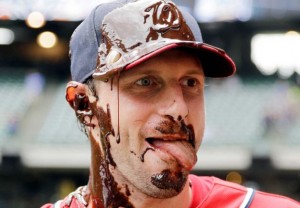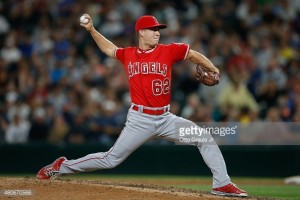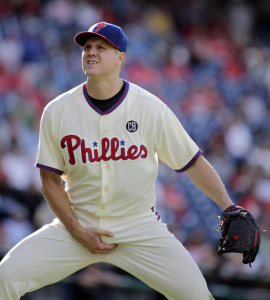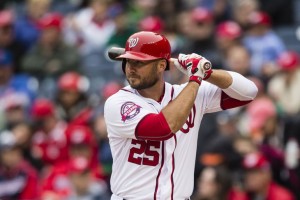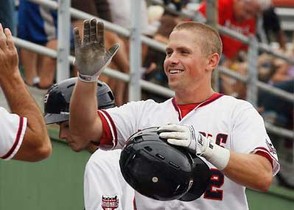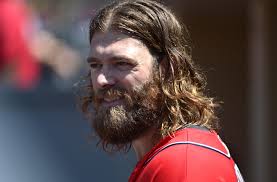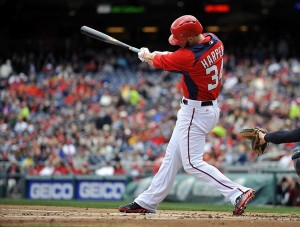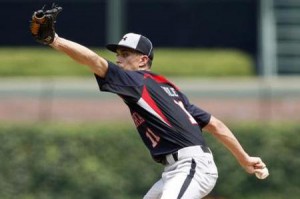Here’s the first in a 7-part series where we delve into the pitching staffs from start to end, from the majors all the way to the GCL. We start with the rotations, review all the starters and then hit up the relievers. We try to predict as we go, which I’ll summarize at the end with a big “2016 predictions” piece.
Here’s 2013’s post and then 2012’s post. We never got to 2014 as I was switching jobs and this series takes a ton of time and I couldn’t do it.
All stats are courtesy of either Baseball-Reference page or via Fangraphs page. Also useful here are the Big Board and the Nats Draft Tracker as always.
Washington starters. The rotation at the beginning of the season was Scherzer, Zimmermann, Strasburg, Gonzalez, Fister. By the end of the season it was basically the same, with Roark replacing Ross who had replaced Fister.
- Max Scherzer: 14-12 with a 2.79 ERA, 0.918 whip with 276/34 K/BB ratio in 228.2 IP (33 starts). Look at that K/BB ratio again: that’s more than 8 strikeouts for every walk for a power pitcher. His season also included two no-hitters (both of which easily could have been perfect games) and a one-hitter, and by one measure (Game Score) his season-ending 17-K no-hitter was nearly the best pitching 9-inning performance ever. If you needed another excuse to ignore W/L records, just look at Scherzer’s record on the year given his peripherals. But even given his season on a macro level, some were rather disappointed in Scherzer because in August, when the chips were down and this team collapsed, he was 0-3 with a 6.43 ERA in 5 starts. Nonetheless, Scherzer more than earned his salary in 2015 and I see no reason not to expect similar results in 2016. Outlook for next season: 2nd straight opening day start.
- Jordan Zimmermann: 13-10, 3.66 ERA, 1.205 whip with 164/39 K/BB over 201.2 IP (33 starts). His ERA was a point higher than in 2014, his WHIP was 10% higher and his FIP was inflated to a very un-Zimmermann 3.75 level. Not exactly the walk year season he was hoping for. Nonetheless, Zimmermann should make out like a bandit on the FA market, where he occupies the lead spot in the 2nd tier of FA pitchers and should do just fine. Unfortunately, it seems like his time in DC is up; we don’t know the size or length of the contract extension he turned down, but it seems obvious that the team didn’t give him what he and his advisers thought he deserved. He’ll be oft-mentioned in the coming weeks as he finds a new home and it’ll be a shame to see him go. Outlook for next season: pitching for another team: Signed with Detroit for 5yrs/$110M.
- Stephen Strasburg: 11-7, 3.46 ERA, 1.107 whip with 155/26 K/BB in 127 IP (23 starts). His end-of-the-year numbers don’t look nearly as bad as the debacle that his season really was. He had a 6.55 ERA through his first 10 starts, then missed most of June and July with two separate D/L trips. Upon his return, he was awesome, dropping his season ERA from 5.16 to 3.46 thanks to 9 quality starts (out of 10) and 5 double-digit strikeout games. But, the damage was done; he was awesome down the stretch in a series of games that ended up being meaningless. On the bright side, the Nats likely save a few million dollars in their arbitration case. Lets just hope that whatever he finally figured out in Aug and Sept continues into next season. Outlook for next season: Nats #2 starter.
- Gio Gonzalez: 11-8, 3.79 ERA, 1.423 whip with 169/69 K/BB in 175.2 IP (31 starts). Another year, another inconsistent season from our #4 starter. The team was 16-15 in his 31 starts, which makes sense since he had exactly 16 quality starts. I think at this point Gio is what he is: a decently valued 4th starter who earns his salary and puts up enough value to keep his spot. The Nats will ride his arm until his contract expires. Outlook for next season: Nats #4 starter.
- Doug Fister: 5-7, 4.19 ERA, 1.398 whip with 63/24 K/BB in 103 IP (25 appearances, 15 starts). MLB’s most underrated starter over the past few years finally had father time catch up to him, going 4-7 with a 4.60 ERA in 15 starts before the team mercifully pulled the plug. His average fastball velocity has been dropping, but dropped precipitously this year (down to 86.1) and just was too hittable. To Fister’s credit, he accepted the move to the bullpen instead of taking the “easy” way out and claiming a D/L trip, and was effective in 17 relief innings to make his season ERA look a little more palatable. Nonetheless, it was not exactly the way the Nats drew things up. Fister faces an uncertain future; he went from being guaranteed a Qualifying Offer to maybe struggling to get a guaranteed offer. In the end, I can see perhaps a west coast team taking a flier on him as a 5th starter with a pillow contract for him to try to regain some value. Outlook for next season: Pitching elsewhere, hopefully as a 5th starter somewhere.
- Joe Ross: 5-5, 3.64 ERA, 1.109 whip with 69/21 K/BB in 76.2 IP (16 appearances, 13 starts). Ross initially got called up to cover for Strasburg’s first injury, and was impressive enough to be the first man in line to replace the suddenly ineffective Fister. He got another 10 mostly effective starts, getting shut down in early September after two ineffective starts where he was uncharacteristically wild (9 of his 21 MLB walks were in his last 2 starts) as he reached a soft innings limit for the year. No complaints here; Ross quickly guaranteed his rotation spot for 2016 with his work during the summer and is making the trade where he was acquired looking even more lopsided. Outlook for next season: Nats #3 starter.
- Tanner Roark: 4-7, 4.38 ERA with 70/26 K/BB in 111 IP (40 appearances, 12 starts). The Nats thanked Roark for his “found gold” 5-win 2014 season by acquiring Scherzer and pushing Roark to the all-important long-man/slop innings guy. Not exactly what Roark probably expected. He did get 5 starts covering for Strasburg in late May-early June but otherwise was yanked all over the place; sometimes being a one-inning middle reliever, then getting 3+ in a blowout loss, even getting higher leverage innings in the 8th and 9th (he even had a save in May). When Fister proved ineffective, the Nats didn’t give the slot to Roark like they should have, instead calling up Ross and leaving Roark pitching in relief (their reason was that he wasn’t stretched out). When it became clear Ross was going to run out of innings, they sent him back to Potomac briefly to “stretch out” and Roark finished the year in the rotation with 6 relatively ineffective starts. Not the year Roark wanted. There was an incredibly long-winded article in beyondtheboxscore.com that seemed to point at Roark’s position on the rubber as the cause of all his ills, but i put Roark’s struggles more simply: pitchers are creatures of habit and when you take a starter and suddenly tell him he’s a one inning reliever, you shouldn’t be surprised when he doesn’t immediately perform in that role. The question the Nats have to face is this: was 2014 a fluke? Do you pencil in Roark for the #5 starter in 2016 or do you try to acquire his replacement? Do you have an open competition between Roark and the slew of AAA arms for the spot? Personally, I’m a Roark believer and think he’ll be just fine if you install him in the rotation and let him work. Outlook for next season: Nats #5 starter.
- Others who got 1-2 Spot Starts:
- Taylor Jordan: got one spot-start in early June, getting pounded by Toronto. He provided long-relief cover a few times here and there throughout the season but wasn’t used even after being called up 9/1 (perhaps an innings limit?). See AAA write-up for more.
- A.J. Cole got one spot start in late April, getting destroyed by Atlanta in the epic 13-12 game. I was highly critical of this particular call-up at the time, questioning why the start didn’t go to Roark at the time. Cole got two other mop-up games to make his ERA slightly less awful for the year, but raised serious questions as to his future. See AAA write-up for more.
Rotation summary: Scherzer was good but struggled when the chips were down. Zimmermann regressed, as did Gonzalez. Strasburg was either awful or hurt most of the season. Fister was abhorrent. Roark was wasted. Yet despite all that negativity surrounding our rotation, the Nats starters as a group were still ranked pretty highly : 3rd in fWAR, 7th in ERA, 4th in FIP. So, it was still a pretty good rotation but not nearly as good as we thought they’d be upon the Scherzer acquisition.
Washington relievers. On opening day the MLB bullpen was Storen, Treinen, Stammen, Thornton, Cedeno, Barrett, Roark. By the time it was over, the team had used no less than *20* relievers. Not exactly how they sketched it out in the off-season. Lets talk about all 20 guys; here they are ordered with closers first, then descending by IP. Anyone with less than 10 innings is relegated to the end with generally a shorter write-up.
- Drew Storen was having a near-all Star calibre season closing, holding a 1.69 ERA with 46/9 K/BB over 37.1 IP and 29 saves. Then suddenly he was demoted thanks to the Papelbon acquisition. His numbers post 7/29/15: 7.13 ERA in 17 innings, which culminated with his 3-walk performance in the season-ending Mets loss in early September (his 5th blown save of the year). Two days later he slammed a locker on his thumb, broke it and was done for the season along with his team. We’ve argued this one to death; there are people who like to argue that players are machines and they are highly paid to do whatever the team asks of them. I maintain that this team has tried over and over to replace Storen thanks to a couple of poorly-timed games of ineffectiveness that just happened to occur in the two NLDS series this team has managed to reach, and the “layering” of Papelbon over top of him was the icing on the cake of his Nats career. I’m sure Storen wants out of town, and I’m sure he’ll be a classic “change of scenery” guy. Mike Rizzo needs to make it happen. Outlook for next season: Closing for another team.
- Jonathan Papelbon was acquired in late July straight up for a relatively low-level prospect (Nick Pivetta), an indication of how desperate Philadelphia was to rid themselves of him. He pitched a grand total of 23.1 innings in two months, through little fault of his own clearly disrupted the karma of the bullpen, and entirely at fault on his own took offense to Bryce Harper‘s non-defense in the press of Papelbon’s over-reaction and subsequent plunking of Manny Machado in a game earlier in that week and decided that calling out one of the game’s premier hustlers for “not hustling” down the line on a routine pop-up was a good idea. Fast forward to the umpteenth unnecessary embarrassing moment for the franchise and perhaps the final nail in the coffin of the inexplicably unaware and dense manager Matt Williams. Fun fact: Papelbon bought a $2.9M house in Alexandria exactly one week before choking his teammate on national TV and getting suspended for the rest of the season. Good timing. I know that Harper has “reached out” to Papelbon and they’re all saying this is just ‘brothers fighting” and all that BS, but Rizzo has to be shopping him for whatever he can get for him, upto and including eating the entirety of his $11M 2016 salary. Many think he’s completely untradeable, but i’m guessing someone will take a flier on him. Outlook for next season: Closing for another team.
- Blake Treinen was the busiest guy in the pen this year (outside of sometimes starter Roark that is), throwing 67.2 innings in 60 innings as mostly an 7th/8th inning guy. He had a 3.86 ERA, a 3.49 FIP, and a 1.389 whip, all incrementally worst in 2015 than the year before. 65/32 K/BB in those 67IP. Treinen features a mid to upper 90s sinking fastball that has so much movement that TV announcers sometimes think its a changeup, yet still has some really odd splits. Righties had just a .493 OPS against him on the year … while lefties teed off to the tune of a .934 OPS. Odd because you’d think that a guy who could throw a fastball that tails away from lefties like Treinen would be more successful. Another oddity; he had a 5.90 ERA at home and just a 2.33 ERA away. So basically, if he was facing a righty on the road, he’s your guy. He has limited his repertoire to just two pitches these days (2-seam sinker and a wipeout slider), and seems so far removed from having anything resembling a third pitch that any thoughts of returning to the bullpen seem long gone. Is Treinen just a ROOGY (right handed one out guy?) Do teams even have that? Maybe his goal for the off-season is to figure out some pitch that is effective against lefties. He also needs to work on his control; his walk rate of 4.3 per nine just won’t cut it for a higher leverage reliever. Outlook for next season: back in his 7th/8th inning role.
- Felipe Rivero, 2.79 ERA, 2.64 FIP, 0.952 whip and 43/11 K/BB in 48.1 relief innings. Rivero was a revelation for the team this year, converting to relief for the first time in his career and really shining. He has some serious heat; max fastball of 99.8 and an average of 95.5 from the left side, but really was a two pitch pitcher this season; fastball and slider (fangraphs distinguishes his 4-seamer from his 2-seamer but the velocities are exactly the same; does he throw two different, distinct fastballs?) Unlike Treinen, Rivero got righties and lefties out at equal clips (.200 BAA for righties, .198 for lefties) and really came into his own in the bullpen. He’s much more than a matchup-lefty and could be a valuable bullpen member for a while. Can he return to starting? Hard to say; does he have a third pitch? Years of starting in the minors seems to indicate that his future remains in the pen. Outlook for next season: reprising his 7th inning reliever role.
- Matt Thornton had an excellent age 38 year; 2.18 ERA, 3.52 FIP, 1.065 ERA in 41.1 relief innings across 60 appearances. His FIP is much higher than his ERA because he doesn’t rely as much on the strikeout; he had just a 23/11 K/BB ratio in those 41.1 innings. His splits showed some interesting tidbits: 10 of his 11 walks on the year came against right handed hitters, while he had an 11/1 K/BB ratio when facing lefties. Thornton is best judged by his performance against lefties and he was excellent; .198/.205/.279, and this is why I’m an advocate of resigning him for 2016. I’m still kind of baffled by his being waived by the Yankees frankly. The FA market for left handed relievers is a little busy; I count 20 lefties out there. But not all of them were as effective as Thornton was in 2015. Can the Nats re-sign him? Do they want to? They do have several in-house loogy replacements to be discussed, if they wanted to save a couple million dollars off of payroll. Outlook for next season: another season as a loogy, for the Nats or elsewhere.
- Casey Janssen: when the Nats acquired Janssen, a three year closer for the Toronto Blue Jays, I figured the team’s late-inning bullpen issues were solved. The loss of Rafael Soriano was inevitable (and, frankly, not really that important given how badly he finished 2014), but the loss of Tyler Clippard was going to be hard to fix. But plugging in a former AL east closer into the 8th inning role? No worries. Well, that’s not quite how it went. Janssen got hurt in spring training, missed the first 7 weeks of the season … and then underwhelmed once he arrived. His numbers on the season: 4.95 ERA, 4.05 FIP, 1.150 whip, with 27/8 K/BB in 40 IP. Perhaps the 4.95 ERA is skewed by a few bad outings: scanning through his game log he gave up 4 runs on 5/30, another 4 runs on 8/31, 3 more the following day (in that infamous St. Louis series) and 2 on 9/27. So of the 22 runs he allowed all year, 13 of them were in four outings. Perhaps so, but his job as an 8th inning guy is not to allow these massive rallies, ever. His fastball velocity has been declining and his 4-seamer sat at just 88.3 MPH on average this year; is that fast enough even if you have pinpoint control and can throw 5 pitches? Apparently not; Janssen’s struggles were a big part of the bullpen’s struggles this year, a big reason they felt the need to acquire Papelbon, and in crunch time towards the end of the season Williams didn’t trust him to give him important assignments. The Nats bought out his option year and cut ties with him; the end of a disappointing season together. Outlook for next season: middle reliever for another organization.
- Aaron Barrett: started out the year looking good as a key 6th/7th inning righty, struggled starting in May, hit the D/L in June, got lit up on Aug 5th to the point of getting demoted to AAA, at which point he (finally) told team doctors that his arm had been bugging him for weeks (months even). A quick scan showed a blown UCL and he underwent Tommy John surgery on September 5th, 2015. Final season stats: 4.60 ERA but a 2.21 FIP, 1.193 whip and 35/7 K/BB in 29.1 innings. Look; you don’t want to wish ill will on a guy for trying to gut it out, but at what point was his arm issues impacting his performance on the field and costing the team games? Outlook for next season: on the 60-day D/L for most if not all the season.
- Sammy Solis was closer to a DFA than a call-up at the end of 2014, a season mostly lost to injury and lost promise of the former 2nd round pick. But a slew of injuries forced him into action in the Nats bullpen and he held up, throwing 21.1 innings of 3.38 ERA, 3.46 fip, 1.359 whip with a 17/4 K/BB ratio. That’s not too bad of a debut, even if it was his age 26 season. He showed a reverse split interestingly, with lefties hitting him at a .355 clip (righties: .255). I have a feeling that the team is likely going to look elsewhere for a second lefty out of the pen. Option number one is probably resigning Matt Thornton, which will relegate Solis to AAA/spare part duty in Syracuse. Outlook for next season: Syracuse bullpen/lefty reliever coverage.
- Matt Grace; 4.24 ERA, 3.08 fip, 2.00 whip with 14/8 K/BB in 17 IP across 26 outings. Grace is a nice story, a guy who really came on strong in 2014 and earned his 40-man slot. But his numbers in his first go-around in the majors were less than ideal. See Solis’ write up and then add on a little pessimism and you have Grace right now; too many baserunners and not enough ability to get right handers out (.429 BAA) to be trusted as an effective major league reliever right now. Outlook for next season: As with Solis Syracuse bullpen/lefty reliever coverage. Except he’s “behind” Solis.
- Rafael Martin: everyone’s favorite story. Signed out of the Mexican leagues, shot up the system posting just ridiculous numbers in AA and AAA in 2013 and 2014. Finally got his shot and had some really odd stat lines: 5.11 ERA, 4.76 FIP, 1.378 whip with 25/5 K/BB in 12.1 major league innings. That’s right; he had an 18.2 K/9 ratio. He struck out 8 of the first 12 batters he faced, including a pretty memorable debut where he struck out 5 guys in two innings in Boston in mid April. He was looking like a made-for-TV-movie story until he took a rough outing in Miami and got sent down … not to be recalled until 9/1. He threw a bunch of garbage time innings in September and got his ERA back down but kept striking guys out with his upper 80s arsenal. Why didn’t he get more of a shot when the chips were down and other right handed relievers were struggling in August? I don’t know. Honestly, I think he’d make an excellent long-man/middle reliever, the classic “7th guy out of the pen” with his ability to go long and spin the ball in there as a change of pace versus harder throwing guys. Something tells me though that he’s going to be back in Syracuse as bullpen insurance. Outlook for next season: Syracuse bullpen/righty reliever coverage.
- David Carpenter: acquired in trade from the Yankees for Tony Renda, threw 6 innings in the majors for the team, got hurt, went to the 60-day D/L with a shoulder issue, outrighted on 11/15/15, refused the assignment and has already signed with Atlanta for 2016. Not exactly the best return for a former 2nd round pick and slightly surprising he was outrighted while there was still room on the 40-man roster (and still is room as we speak). Outlook for next season: in Atlanta organization.
- Craig Stammen: threw just 4 innings before requiring elbow surgery. A huge blow for a guy who had been a team leader in IP and an effective middle reliever for years. He’s arbitration eligible, and the team could not arrive at an equitable deal ahead of the 12/2/15 non-tender deadline, so Stammen was non-tendered. I have a feeling that if the team still wants him for 2016 and will work out some sort of heavy incentive-laden deal to keep him in the fold (he’s been with the organization since 2005 after all, tying him for the longest tenured player still with the team now that Ian Desmond has declared FA. Outlook for next season: hopefully back in his 7th inning middle relief role, perhaps pitching elsewhere.
- Xavier Cedeno: threw 3 innings, gave up 3 hits, 2 walks and two runs, then was inexplicably DFA’d and traded to the Dodgers for “cash.” The Dodgers then turned around and traded him to Tampa, where he put up a 2.09 ERA in 43 IP in 2015. What the heck happened here? We talked about it in this space when it happened, and the quick hook DFA was as inexplicable then as it seems now. Was this perhaps the first precursor into the questionable bullpen management that plagued Matt Williams all year? Outlook for next season: a valuable loogy for Tampa.
- Other Relievers who pitched too few innings for analysis:
- Taylor Hill: provided 12 innings of bullpen coverage in Late May-Early June: see AAA write-up.
- Abel de los Santos: added to the 40-man, called up and started his service clock (oh, and burned an option too while they were at it) so that he could throw to exactly eight (8) batters in mid-july before being returned to Harrisburg. Ridiculous use of resources frankly. See AA write-up.
- Position players Clint Robinson and Tyler Moore became the 1st and 2nd position players to ever hurl for the Washington franchise, each throwing the final inning in a blow-out loss.
Bullpen summary: Ugh, what a mess from start to finish. Under performance, injuries, and a rotating door of guys trying to perform. By the end of August there wasn’t anyone even worth trusting in that pen, as evidenced in the critical Mets home series where the season was lost. Even given that, the bullpen as a whole ranked 12th in fWAR, 10th in ERA, 9th in FIP, so it wasn’t really that bad league-wide. Which surprised me too when I went to fangraphs to pull the data. Some more telling stats: 7th in the league in Blown saves with 27. 17th in total saves. 17th in Holds.
Pitching summary overall: we expected more, and in the end the performance of the staff and bullpen probably wasn’t the sole reason this team failed to win the NL East. But it didn’t help.
